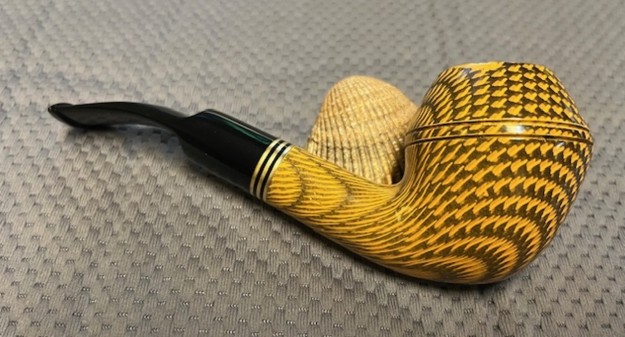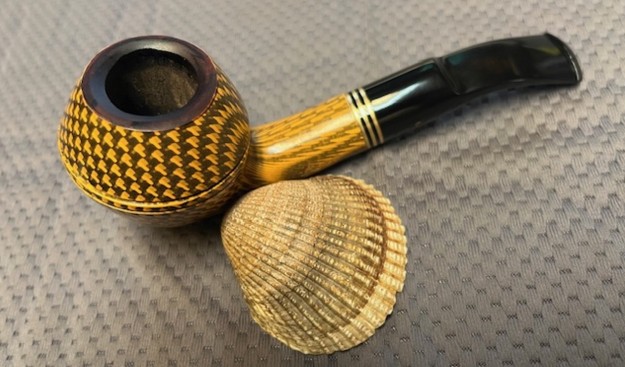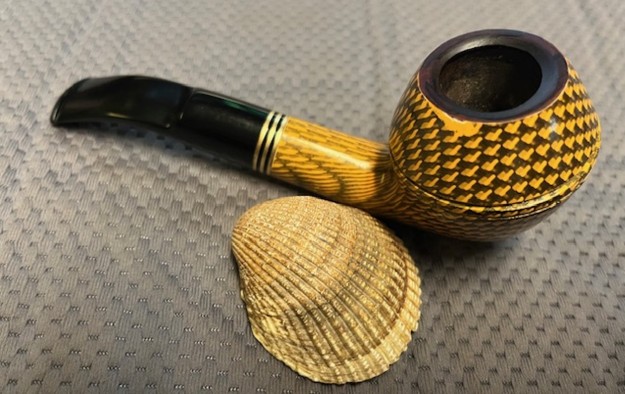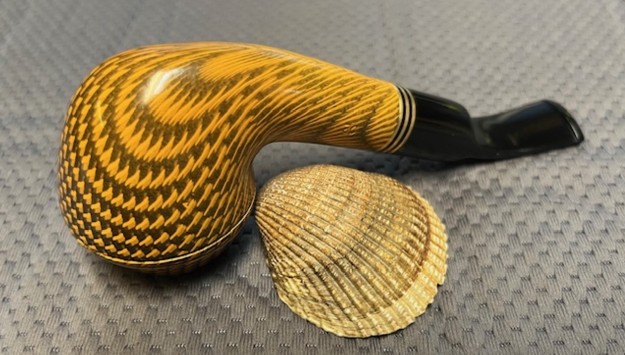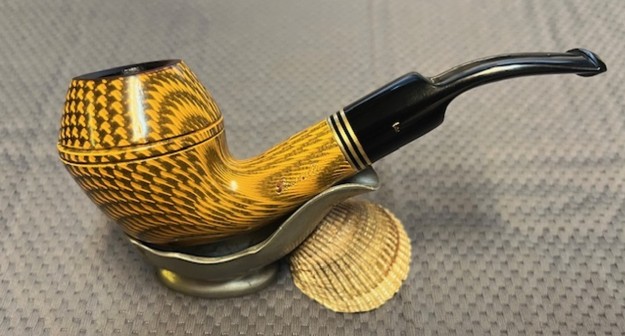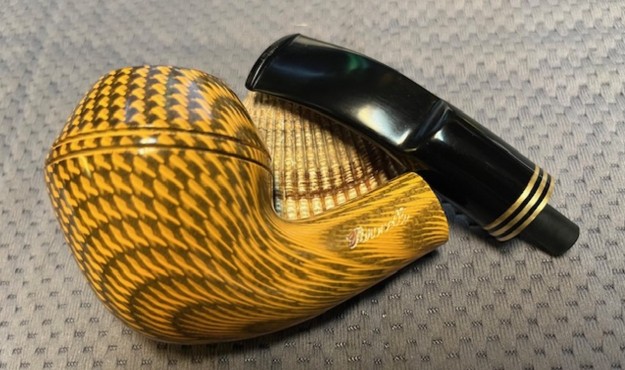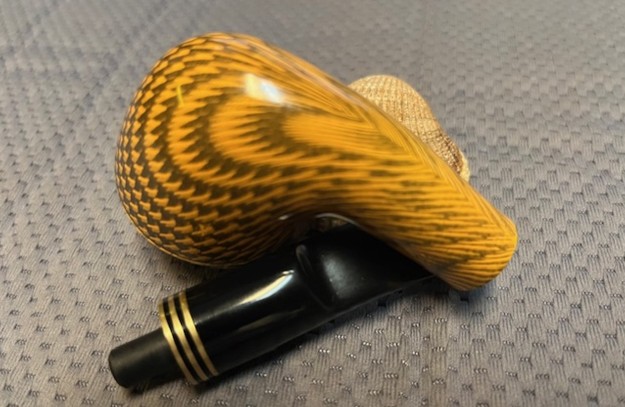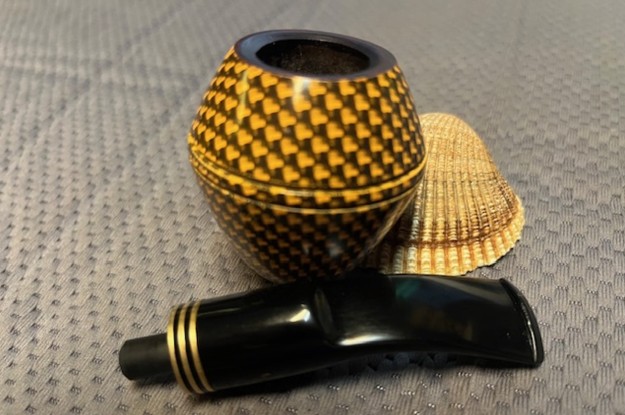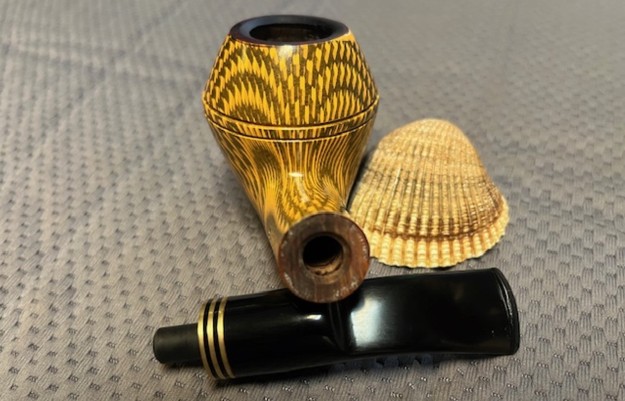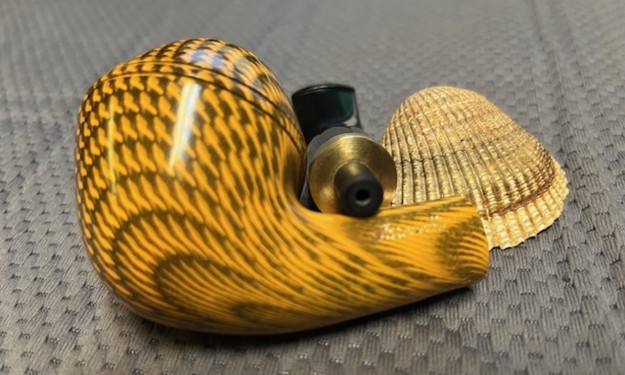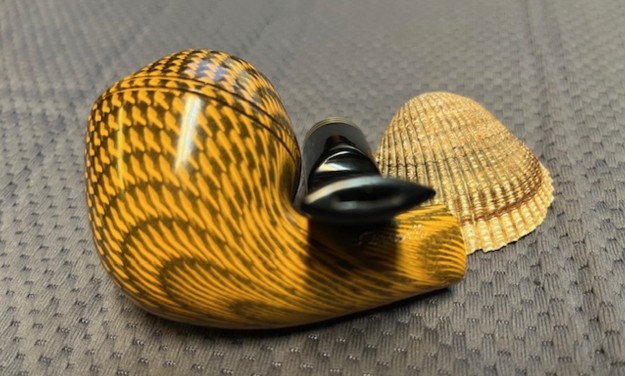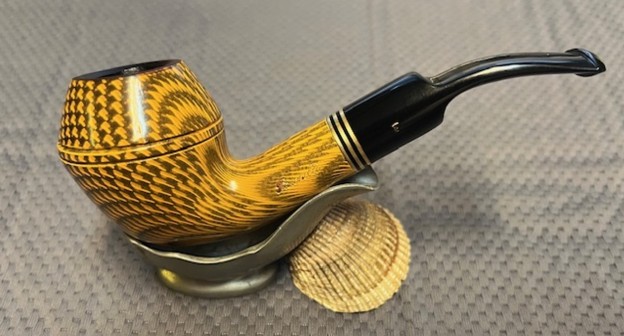Blog by Steve Laug
The next pipe on the work table is an interesting almost psychedelic yellow Bulldog/Rhodesian shape with swirling, almost moving lines in the finish that seemed to move when you stared at it. It is stamped with a gold coloured stamping. On the left side it read Paronelli in script. On the right side it had the shape number 02 and, on the underside, it is stamped Italy. It came from a lot we purchased from a seller on eBay on 01/22/2024 from a seller in Jordan, Minnesota, USA. It is very nicely shaped Rhodesian/Bulldog shaped bowl with an acrylic saddle stem. It has a painted finish as noted above with a yellow undercoat and a pattern of swirling lines almost moving around the bowl sides and cap. The bowl has a thick cake and some lava overflow on the rim top and inner edge. The painted rim top was damaged and the paint was worn off. There was some burn damage on the front right top and inner edge. The stem had a three ring brass band and a gold P logo stamp on the left side of the saddle. It is dirty and has tooth chatter and tooth marks on both sides ahead of the button. Jeff took photos of the pipe before he started his cleanup.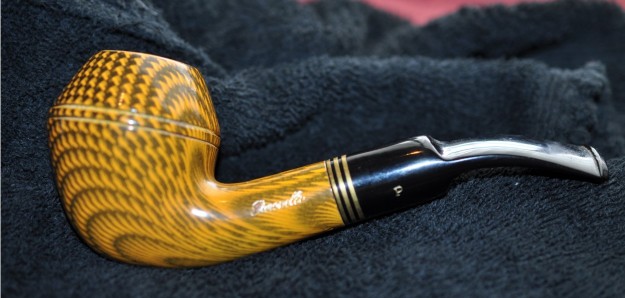
 He took photos of the pipe’s bowl and rim top to show the cake in the bowl and the lava coat overflowing onto the top. You can also see the burn damage to the front right inner edge of the bowl, the missing paint coat and the thick lava coat on the top. It is another dirty pipe. He also took photos to capture the tooth marks on the top and underside of the stem near the button.
He took photos of the pipe’s bowl and rim top to show the cake in the bowl and the lava coat overflowing onto the top. You can also see the burn damage to the front right inner edge of the bowl, the missing paint coat and the thick lava coat on the top. It is another dirty pipe. He also took photos to capture the tooth marks on the top and underside of the stem near the button. 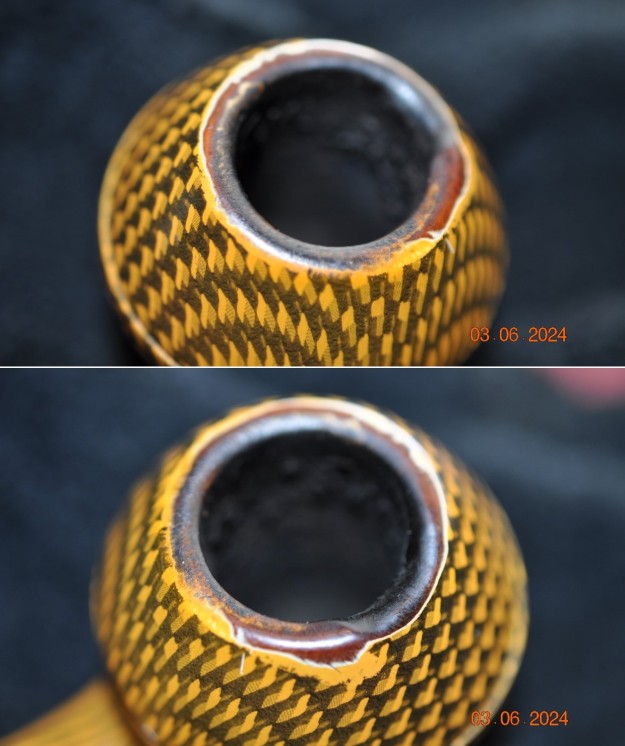
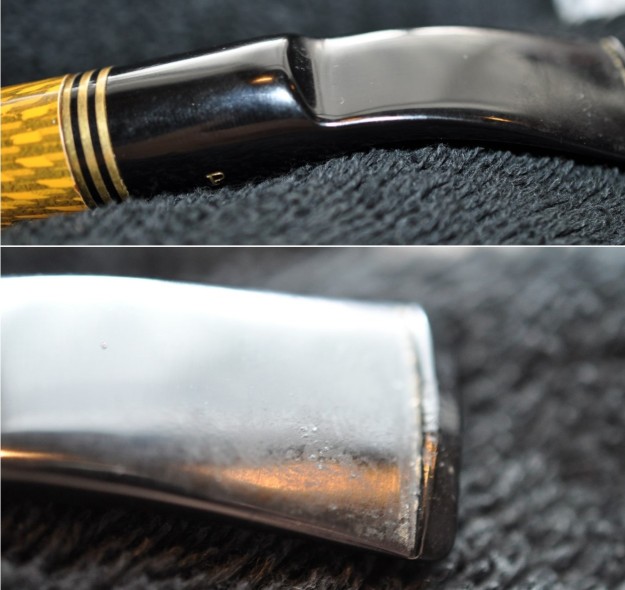
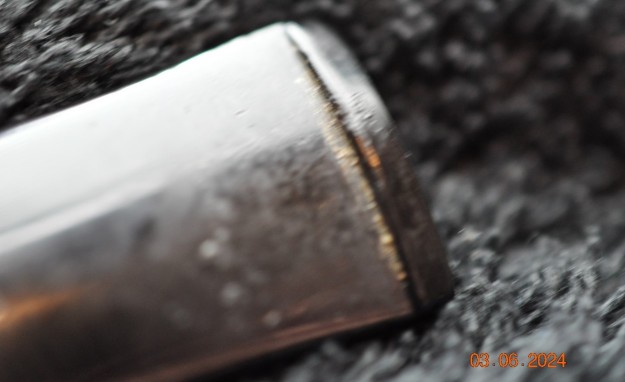 He took photos of the sides and the heel of the bowl to give a sense of the painted finish on this one. Even under the grime and wear finish still has the ability to make you dizzy!
He took photos of the sides and the heel of the bowl to give a sense of the painted finish on this one. Even under the grime and wear finish still has the ability to make you dizzy!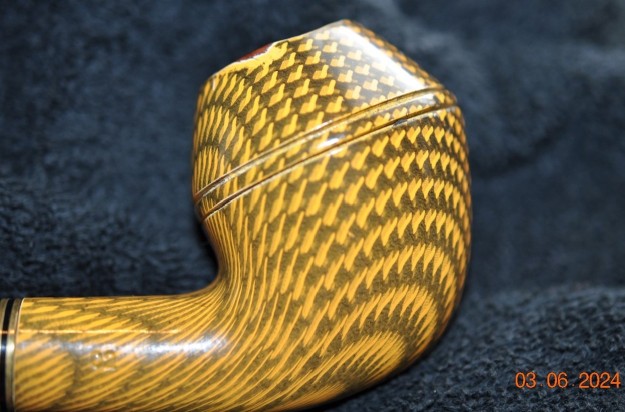
 Jeff took photos of the stamping on the sides of the shank and it is readable. It reads as noted above.
Jeff took photos of the stamping on the sides of the shank and it is readable. It reads as noted above.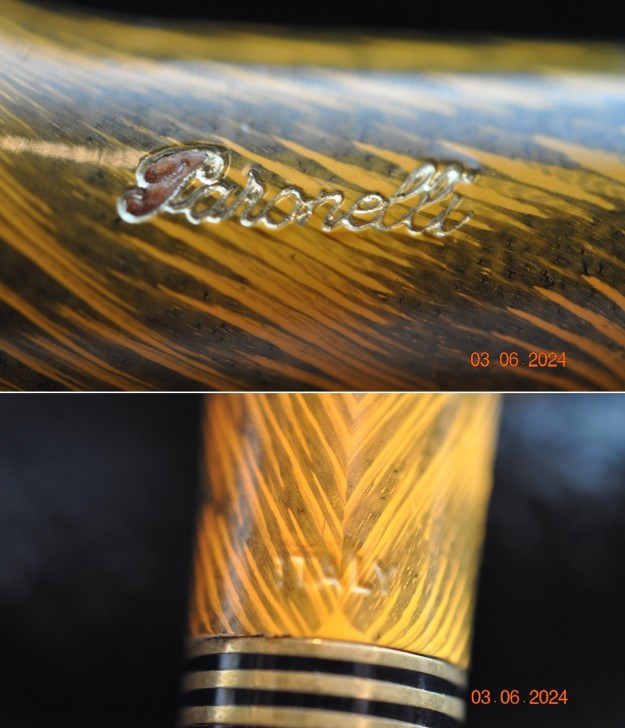
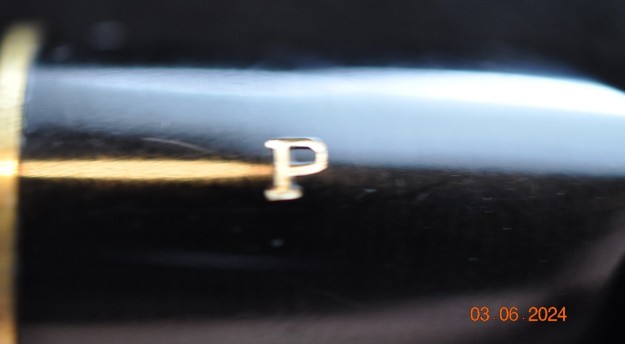 I turned first to Pipephil’s site (http://www.pipephil.eu/logos/en/logo-p1.html) to gather some initial information on the brand. I did a screen capture of the section on the site that gave some pictures of the styles of pipes that were made by Paronelli.
I turned first to Pipephil’s site (http://www.pipephil.eu/logos/en/logo-p1.html) to gather some initial information on the brand. I did a screen capture of the section on the site that gave some pictures of the styles of pipes that were made by Paronelli.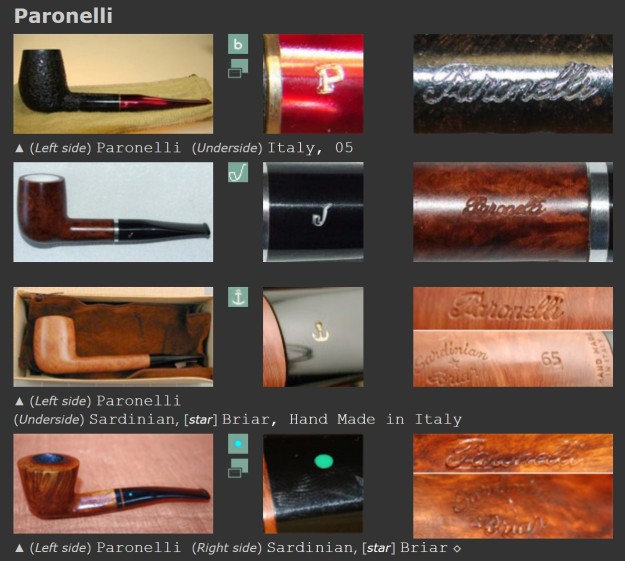 From there I turned to Pipedia (https://pipedia.org/wiki/Alberto_Paronelli) in order to add to my information on the brand. I quote the article below.
From there I turned to Pipedia (https://pipedia.org/wiki/Alberto_Paronelli) in order to add to my information on the brand. I quote the article below.
The brand Paronelli collects inside a family passion that was born in 1945 when Jean-Marie Alberto Paronelli decided to give free rein to his artistic side. The continuous search for quality and perfection brought Alberto Paronelli to create unique pieces prized and sought after worldwide. The ideas and the canons of the founder have been handed down from generation to generation and even now all the pipes are handmade with Italian first choice briar. His grandson, Ariberto Paronelli, which has succeeded over the years at the helm, continues with passion and dedication to the work started by the founder of designing and creating classics models with a modern twist. Annual production is around 1000 pieces. Ariberto also works on commission. If you have in mind a pipe of your dreams he will be happy to achieve it. For Paronelli family the pipe is a matter of the heart.
Jean Marie Alberto Paronelli was born in Gavirate on 21st December 1914. After studying in Switzerland and Italy, he went to London at the age of 18 to complete his vocational training. He turned out to be cut out for foreign languages, so much so that he spoke and wrote English, French, German and Spanish fluently. He studied and became fond of humane letters and people’s history. In London he used to hang out at the Savoy Hotel and got to know Pipe art, as he used to go to Burlington Arcade’s shops regularly. He first became collector and then consultant for other collectors. After he came back to Italy he started to work for Leonida Rossi and established an office in Milan to trade Rossi pipes. In the Sixties he bought the beautiful directory style sample room of the factory, which had just closed down. He regularly corresponded with the major living intellectuals passionate about pipe art, and he founded the magazine “La Pipa”.
Alberto Paronelli was a unique and fantastic personality in pipe’s world, as defined in the presentation of the great designers from Brebbia, for which he designed an egg-shaped curved model. He believed in human relations and friendship above all. Even now enthusiasts from all over the world meet in his house and in the near Museum of the Pipe. He used to tell lots of pleasant anecdotes. You felt like a child in a fairyland and began to understand that Alberto told a different story to everyone to teach them something. What struck most was his vitality, typical of those who have never worked a day, because he did work with great passion. In his museum of the Pipe, open to new and old friends, you can still find journalists looking for an interesting subject to write about, sculptors and friends, ceramists. His creativity expressed in words but also in painting and sculpture. He enjoyed painting very much, but he also enjoyed modeling clay. After studying the Mayan culture he modeled a beautiful series of statuettes.
I turned to work on the pipe itself. Jeff had done an amazing cleanup of the pipe. He reamed the cake with a PipNet reamer and cleaned up that with a Savinelli Fitsall Pipe Knife. He scrubbed the internals of the bowl and stem with alcohol, cotton swabs, pipe cleaners and shank brushes. He scrubbed the externals with undiluted Murphy’s Oil Soap and rinsed the bowl off with running water. The rim top had some remaining paint damage and a burned area on the right front top and edge that would need to be worked on. He soaked the stem in Briarville’s Pipe stem Deoxidizer and once it had soaked rinsed it off with warm water to remove the residual solution. He dried it off and rubbed it down to remove any oxidation that was still on the stem. The pipe looked better when I received it. The issues that remained on the pipe were very clear in the photos that follow.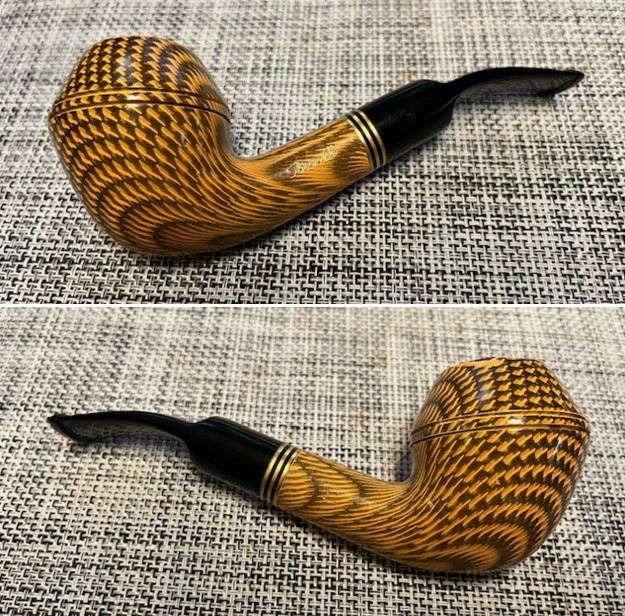
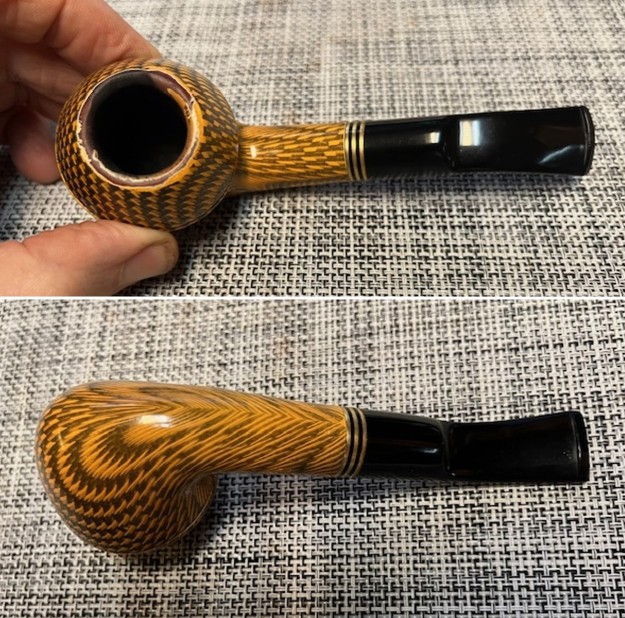 I took a photo of the rim top to show the condition. It looks good with the tars and oils removed from the rim top. The rim top shows paint that has been worn off the top and outer edges of the rim. There is also some burn damage on the right front top and edges. The bowl itself was very clean. The stem came out looking quite good with some light tooth marks and chatter on both sides ahead of the button.
I took a photo of the rim top to show the condition. It looks good with the tars and oils removed from the rim top. The rim top shows paint that has been worn off the top and outer edges of the rim. There is also some burn damage on the right front top and edges. The bowl itself was very clean. The stem came out looking quite good with some light tooth marks and chatter on both sides ahead of the button.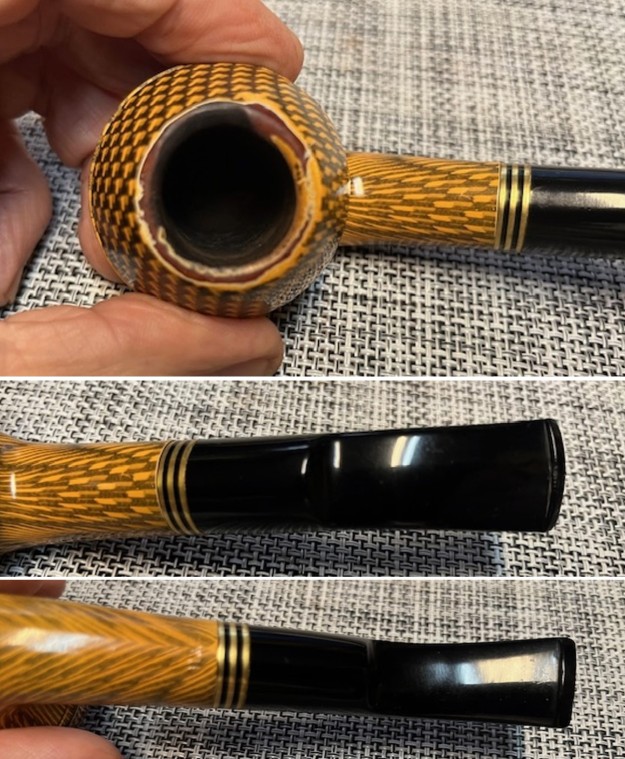 I took a photo of the underside of the shank to show the stamping. The photo shows the stamping and is actually more readable in person. I removed the stem from the shank and took a photo of the pipe parts to show what I was working with. It is a well shaped and strangely mesmerizing pipe.
I took a photo of the underside of the shank to show the stamping. The photo shows the stamping and is actually more readable in person. I removed the stem from the shank and took a photo of the pipe parts to show what I was working with. It is a well shaped and strangely mesmerizing pipe.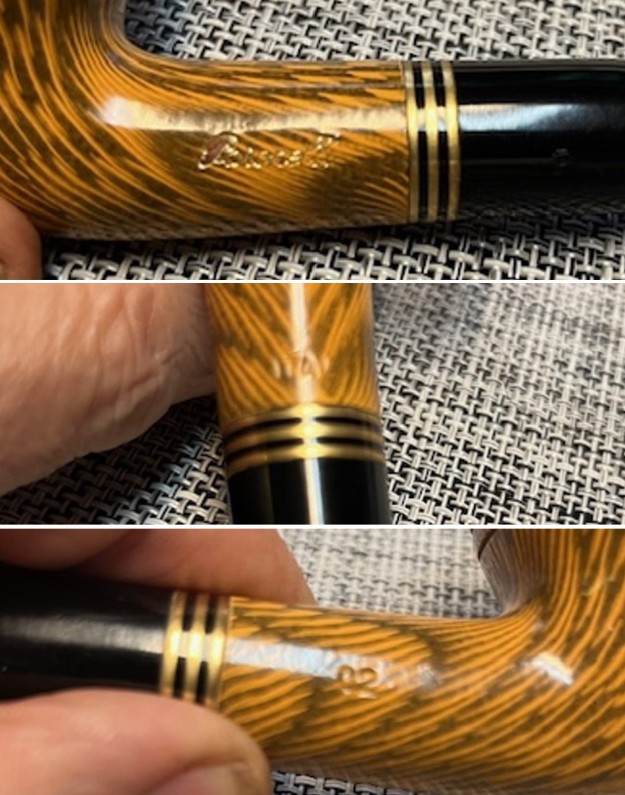
 I started my work on this pipe by addressing two issues that were glaringly present. The first of these was some white paint that was on the shank face when I removed the stem. I carefully sanded the paint of with a folded piece of 220 grit sandpaper. It looked very good once I had finished.
I started my work on this pipe by addressing two issues that were glaringly present. The first of these was some white paint that was on the shank face when I removed the stem. I carefully sanded the paint of with a folded piece of 220 grit sandpaper. It looked very good once I had finished.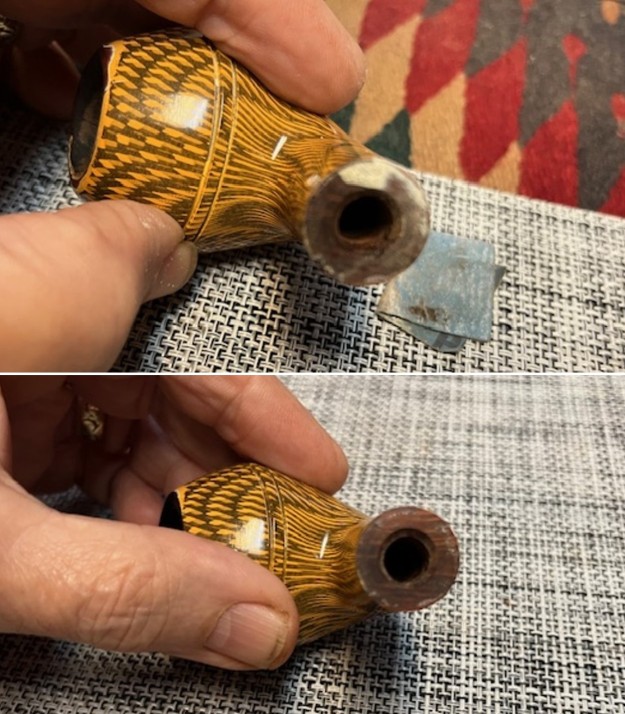 The second issue was the damage to the rim top and the chipped and missing paint. I lightly topped the bowl on 220 grit sandpaper and a topping board. I wrapped a wooden ball with some 220 grit sandpaper and gave the inner edge of the bowl a light bevel. It remove the burn damage and the chipping paint on the surface. I used a Mahogany and a Walnut stain pen try to match the darker portion of the colour on the bowl surface. It looked very good.
The second issue was the damage to the rim top and the chipped and missing paint. I lightly topped the bowl on 220 grit sandpaper and a topping board. I wrapped a wooden ball with some 220 grit sandpaper and gave the inner edge of the bowl a light bevel. It remove the burn damage and the chipping paint on the surface. I used a Mahogany and a Walnut stain pen try to match the darker portion of the colour on the bowl surface. It looked very good.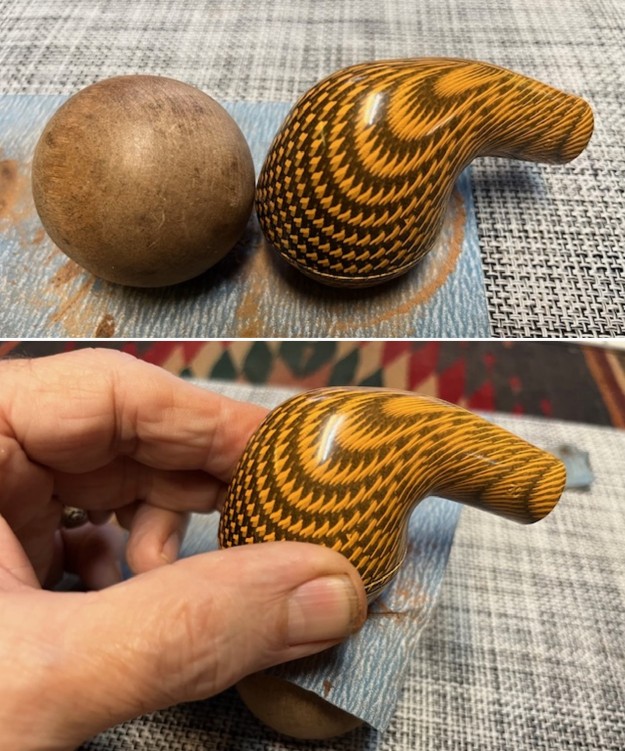
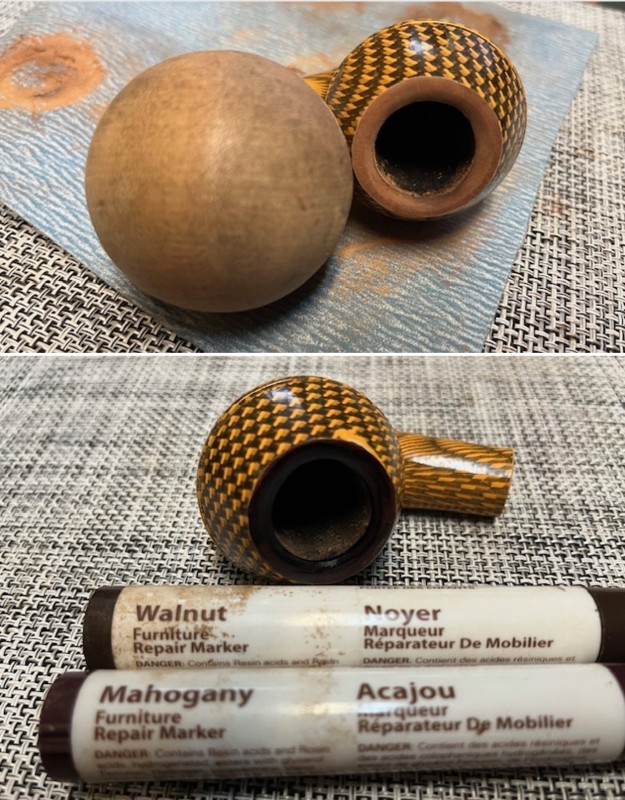 I rubbed the exterior of the bowl and rim top down with Before & After Restoration Balm. I worked it into the surface with my fingertips. The product works to clean, enliven and preserve the briar. I let it sit for 10 minutes then I buffed it with a cotton cloth to deepen the shine. The pipe really comes alive with the balm.
I rubbed the exterior of the bowl and rim top down with Before & After Restoration Balm. I worked it into the surface with my fingertips. The product works to clean, enliven and preserve the briar. I let it sit for 10 minutes then I buffed it with a cotton cloth to deepen the shine. The pipe really comes alive with the balm.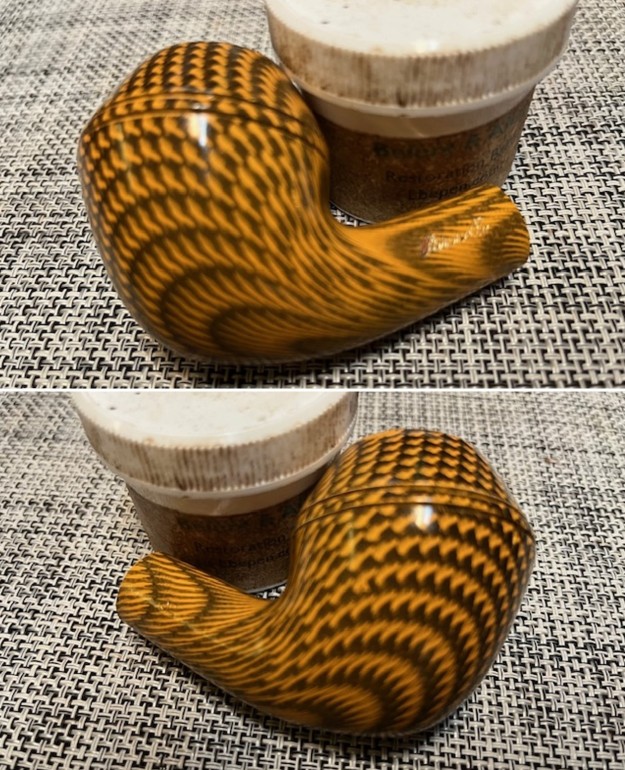
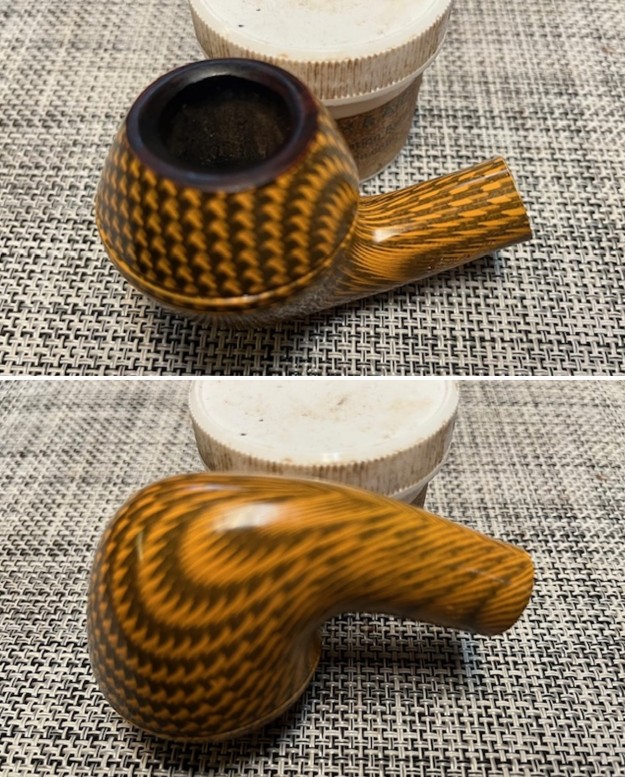
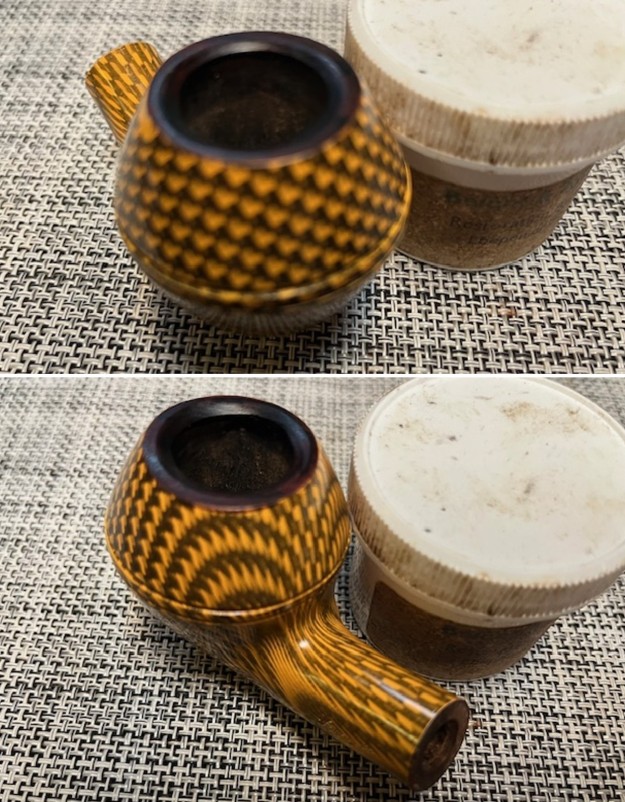 I sanded the stem with 320-3500 grit sanding pads. I wiped it down after each sanding pad with a damp cloth. By the final 3500 grit sanding pad the stem had a had a shine.
I sanded the stem with 320-3500 grit sanding pads. I wiped it down after each sanding pad with a damp cloth. By the final 3500 grit sanding pad the stem had a had a shine.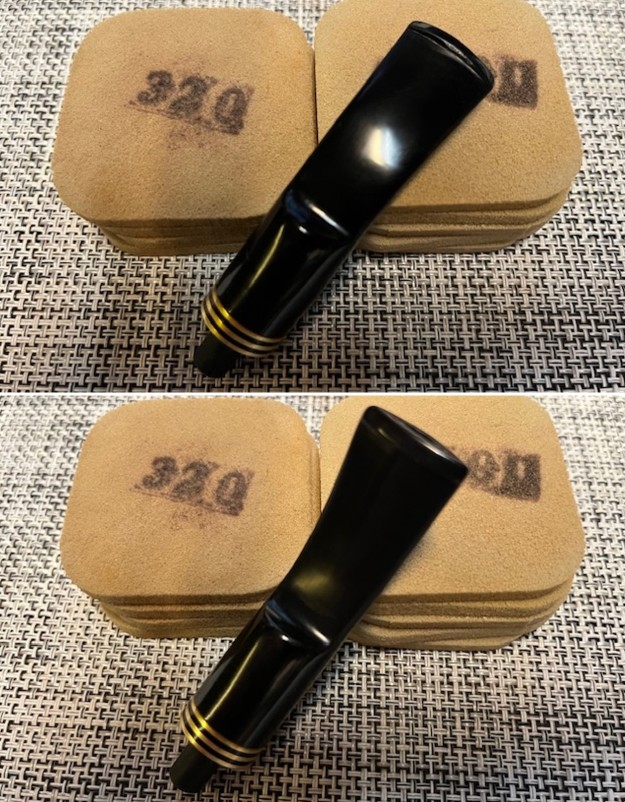 I used some Rub’n Buff Antique Gold to fill in the “P” stamp on the left side of the stem. I worked it into the stamp with a tooth pick and buffed off the excess with a cotton pad. It looked better.
I used some Rub’n Buff Antique Gold to fill in the “P” stamp on the left side of the stem. I worked it into the stamp with a tooth pick and buffed off the excess with a cotton pad. It looked better.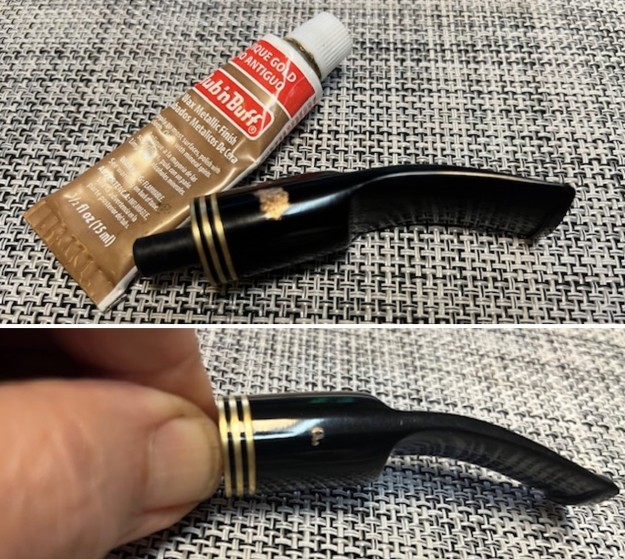 I polished the stem with micromesh sanding pads – 1500-12000 grit pads. I wiped it down with Obsidian Oil after each sanding pad. I used Before & After Pipe Polish – both Fine and Extra Fine to further polish the stem.
I polished the stem with micromesh sanding pads – 1500-12000 grit pads. I wiped it down with Obsidian Oil after each sanding pad. I used Before & After Pipe Polish – both Fine and Extra Fine to further polish the stem.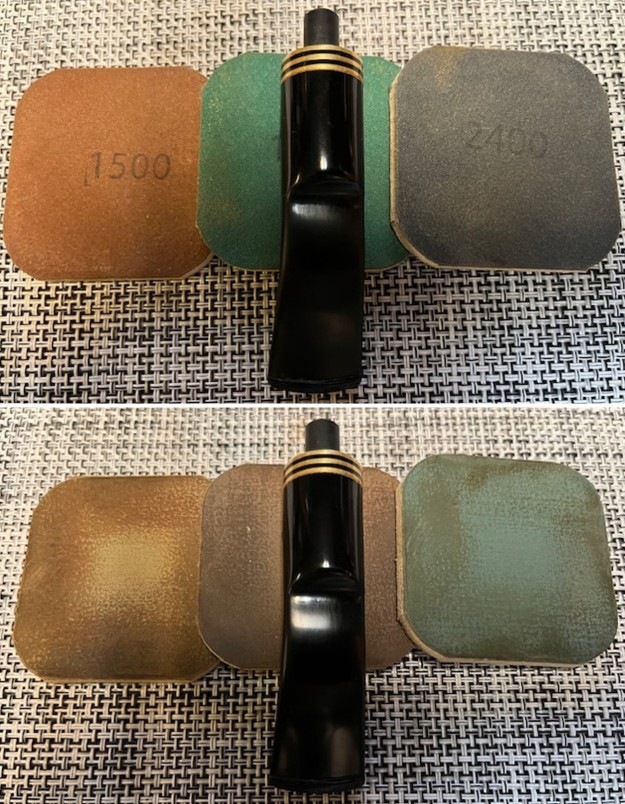
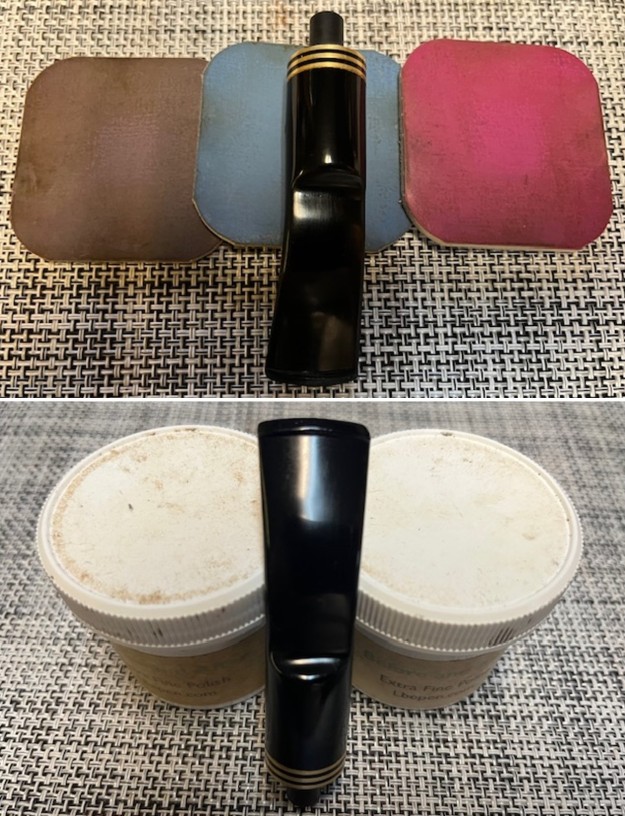 This Italian Made Paronelli 2 Rhodesian with an acrylic saddle stem has a unique and oddly psychedelic yellow and dark painted finish. The pipe has a classic shape with a very 70’s finish. The polished acrylic saddle stem adds to the mix. I put the stem back on the bowl and buffed the pipe by hand to avoid removing any of the finish. I gave the bowl and the stem multiple coats of Conservator’s Wax and followed that by hand buffing it with a soft cloth to deepen the shine. The finished Paronelli 2 Rhodesian is quite unique and feels great in the hand. Give the finished pipe a look in the photos below. The dimensions of the pipe are Length: 6 inches, Height: 2 inches, Outside diameter of the bowl: 1 ¼ inches, Chamber diameter: 7/8 of an inch. The weight of the pipe is 2.36 ounces/67 grams. Thanks for walking through the restoration with me as I worked over another beautiful pipe. This one will be going on the rebornpipes store in the Italian Pipe Makers Section. Thanks for your time.
This Italian Made Paronelli 2 Rhodesian with an acrylic saddle stem has a unique and oddly psychedelic yellow and dark painted finish. The pipe has a classic shape with a very 70’s finish. The polished acrylic saddle stem adds to the mix. I put the stem back on the bowl and buffed the pipe by hand to avoid removing any of the finish. I gave the bowl and the stem multiple coats of Conservator’s Wax and followed that by hand buffing it with a soft cloth to deepen the shine. The finished Paronelli 2 Rhodesian is quite unique and feels great in the hand. Give the finished pipe a look in the photos below. The dimensions of the pipe are Length: 6 inches, Height: 2 inches, Outside diameter of the bowl: 1 ¼ inches, Chamber diameter: 7/8 of an inch. The weight of the pipe is 2.36 ounces/67 grams. Thanks for walking through the restoration with me as I worked over another beautiful pipe. This one will be going on the rebornpipes store in the Italian Pipe Makers Section. Thanks for your time.
